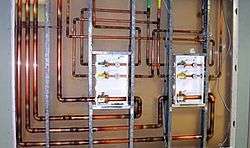Medical gas supply

Medical gas supply systems in hospitals, and most other healthcare facilities, are essential for supplying piped oxygen, nitrous oxide, nitrogen/surgical air, carbon dioxide, oxygen/nitrous oxide 50/50, medical vacuum, anaesthetic gas scavenge/waste anesthetic gas disposal and medical air to various parts of the facility. Source equipment systems are monitored by central/source alarm systems, at the point of supply with multiplexed repeater alarms throughout the facility and for monitoring high and low gas pressure in particular areas such as general ward, operating theatres, ICU/ITU/CCU/NICU, recovery, major treatment rooms, etc. Equipment is connected to the medical gas supply system via station outlets. For emergency gas control area zone service valves are installed in order to prevent contaminated gas going to patient or to stop gas flowing to an area in the event of fire. Valves are positioned at the entrance to all departments and can be accessed via emergency pull out windows.
Oxygen
Oxygen may be used for patients requiring supplemental oxygen via mask. Usually accomplished by a large storage system of liquid oxygen at the hospital which is evaporated into a concentrated oxygen supply, pressures are usually around 345-380 kPa (50-55 psi),[1] or in the UK and Europe, 4-5 bar.[2] This arrangement is described as a vacuum insulated evaporator (VIE) or bulk tank.[3] In small medical centers with a low patient capacity, oxygen is usually supplied by a manifold of multiple high-pressure cylinders. In areas where a bulk system or high-pressure cylinder manifold is not suitable, oxygen may be supplied by an oxygen concentrator. However, on site production of oxygen is still a relatively new technology.
Medical air
Medical air is compressed air supplied by a special air compressor, through a dryer (in order to maintain correct dew point levels), and distributed to patient care areas. In smaller facilities, medical air may also be supplied via high-pressure cylinders. Pressures are maintained around 345-380 kPa (50-55 psi).
Nitrous oxide
Nitrous oxide is supplied to various surgical suites for its anaesthetic functions during pre-operative procedures. It is delivered to the hospital in high-pressure cylinders and supplied through the Medical Gas system. Some bulk systems exist, but are no longer installed due to environmental concerns and overall reduced consumption of Nitrous oxide. System pressures are around 345 kPa (50 psi), 4 bar UK.
Nitrogen
Nitrogen is typically used to power pneumatic surgical equipment during various procedures, and is supplied by high-pressure cylinders. Pressures range around 1.2 MPa (175 psi) to various locations.
Instrument air/surgical air
Like Nitrogen, Instrument air is used to power surgical equipment. However, it is generated on site by an air compressor (similar to a Medical air compressor) rather than high-pressure cylinders. Early air compressors could not offer the purity required to drive surgical equipment. However, this has changed and instrument air is becoming a popular alternative to Nitrogen. As with Nitrogen, pressures range around 1.2 MPa (175 psi). UK systems are supplied at 11 bar to the local area and regulated down to 7-8 bar at point of use.
Carbon dioxide
Typically used for insufflation during surgery, and also used in laser surgeries. System pressures are maintained at about 345 kPa (50 psi), UK 4 bar. It is also used for certain respiratory disorders.
Medical vacuum
Medical vacuum in a hospital supports suction equipment and evacuation procedures, supplied by vacuum pump systems exhausting to the atmosphere. Vacuum will fluctuate across the pipeline, but is generally maintained around -75 kPa (-22 inHg), (450mmHg UK).
WAGD/AGSS
Waste anesthesia gas disposal (WAGD), or Anaesthetic gas scavenging system (AGSS), is used in hospital anaesthesia evacuation procedures. Although it is essentially the same as a Medical vacuum system, some building codes require anaesthetic gases to be scavenged separately. Scavenging systems do not need to be as powerful as medical vacuum systems, and can be maintained around -50 to -65 kPa (-15 to -19 inHg).
Medical gas mixtures
There are many gas mixtures used for clinical and medical applications. They are often used for patient diagnostics such as lung function testing or blood gas analysis. Test gases are also used to calibrate and maintain medical devices used for the delivery of anaesthetic gases. In laboratories, culture growth applications include controlled aerobic or anaerobic incubator atmospheres for biological cell culture or tissue growth. Controlled aerobic conditions are created using mixtures rich in oxygen and anaerobic conditions are created using mixtures rich in hydrogen or carbon dioxide. Supply pressure is 4 bar.
Two common medical gas mixtures are Entonox and Heliox.
References
- ↑ NFPA 99: Health Care Facilities Code (2015)
- ↑ ISO 7396-1:2016 Medical gas pipeline systems - Part 1: Pipeline systems for compressed medical gases and vacuum
- ↑ http://www.frca.co.uk/article.aspx?articleid=100342
Template:HTM02-01 Part A
External links
| Wikimedia Commons has media related to Medical gas supply. |